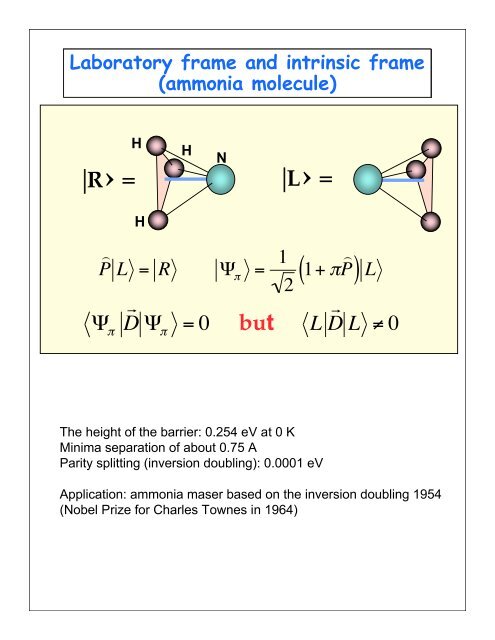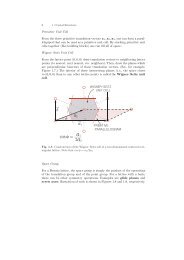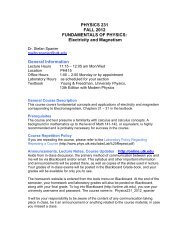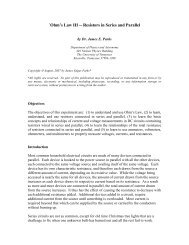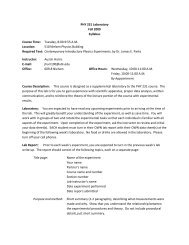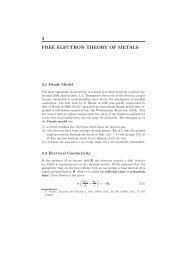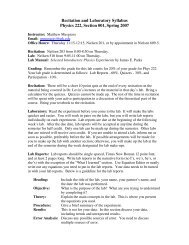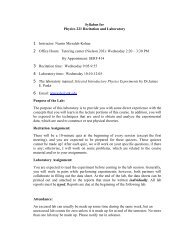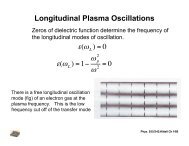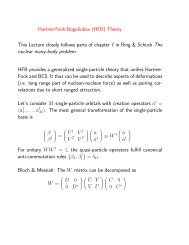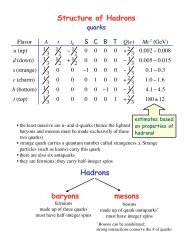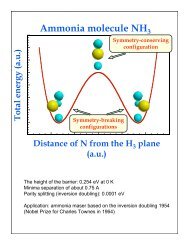Spontaneous symmetry breaking
Spontaneous symmetry breaking
Spontaneous symmetry breaking
Create successful ePaper yourself
Turn your PDF publications into a flip-book with our unique Google optimized e-Paper software.
Laboratory frame and intrinsic frame<br />
(ammonia molecule)<br />
H<br />
H<br />
H<br />
|R› = |L› =<br />
" #<br />
r<br />
D " #<br />
= 0<br />
N<br />
)<br />
P L = R " #<br />
= 1 2 1+ # P<br />
)<br />
but<br />
( ) L<br />
L r<br />
D L " 0<br />
!<br />
!<br />
The height of the barrier: 0.254 eV at 0 K<br />
Minima separation of about 0.75 A<br />
Parity splitting (inversion doubling): 0.0001 eV<br />
Application: ammonia maser based on the inversion doubling 1954<br />
(Nobel Prize for Charles Townes in 1964)
The transition matrix element between the members of the doublet<br />
carries important information about the collectivity of the system.<br />
The normalized signature-projected LM wave functions are:<br />
Since K x is signature-odd, one has<br />
Consequently, the transition matrix element is:<br />
For large values of χ, this matrix element becomes<br />
In the limit of large χ, the transition matrix element carries<br />
information about the deformation of the system!
Laboratory frame and intrinsic frame<br />
(molecular or nuclear quadrupole moment)<br />
Q =<br />
2K 2 -I(I+1)<br />
Q<br />
(I+1)(2I+3) 0<br />
MEASURED<br />
INTRINSIC<br />
RELATIVE<br />
MOTION<br />
Q=0 for I=K=0, independently of Q 0 !
Symmetry <strong>breaking</strong><br />
q = !<br />
= 0 but<br />
0 0 0<br />
Q ˆ<br />
! crit<br />
E<br />
ω RPA<br />
=0<br />
ω RPA<br />
>0 ω RPA<br />
-<br />
imag.<br />
Vibrator<br />
(weak<br />
coupling)<br />
Soft<br />
(interm.<br />
coupling)<br />
Rotor<br />
(strong<br />
coupling)<br />
No phase<br />
Band structures<br />
transition<br />
labelled by<br />
in the finite<br />
different q.n.<br />
system!<br />
[ H ˆ S ˆ ] h ˆ , S ˆ<br />
deformed<br />
intrinsic<br />
system!<br />
Q 2 !<br />
“exact”<br />
mean field<br />
of the internally<br />
broken symmetries<br />
[ ] ! 0
Nuclear deformation:<br />
spontaneous <strong>symmetry</strong> <strong>breaking</strong><br />
Molecular physics: Jahn-Teller effect 1937<br />
Any configuration of atoms or ions (except a<br />
linear chain) can develop a stable <strong>symmetry</strong><strong>breaking</strong><br />
deformation provided the coupling<br />
between degenerate electronic excitations and<br />
collective molecular vibrations is strong.<br />
Nuclear physics: Bohr-Mottelson 1952-53<br />
Any nuclear configuration can develop a stable<br />
<strong>symmetry</strong>-<strong>breaking</strong> deformation provided the<br />
coupling between degenerate single-nucleonic<br />
excitations and collective nuclear modes is<br />
strong.<br />
The unified model. Particle vibration coupling<br />
V int<br />
= !" r<br />
( ) # $µ<br />
$µ<br />
( )<br />
% Y $µ<br />
&
Intrinsic symmetries<br />
5 - ν=1<br />
3 -<br />
1 -<br />
(parallel band)<br />
D •h (C 2 , P)<br />
O<br />
C<br />
O<br />
6 +<br />
4 +<br />
2 +<br />
0 +<br />
ν=0<br />
(ground band)<br />
CO 2<br />
- an axially symmetric molecule with no static dipole moment.<br />
O<br />
C<br />
O<br />
C •ν (S=C 2 P)<br />
3 -<br />
2 +<br />
O N<br />
4 +<br />
1 -<br />
0 +<br />
N 2<br />
O - an axially symmetric molecule with static dipole moment.


